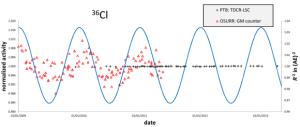
A group of US American scientists had recently published measurement data concerning the radioactive isotope Chlorine-36. The measurement values showed fluctuations according to the seasons, which the researchers explained by corresponding changes in the decay rate of the nuclide. They attributed these fluctuations in the decay rates of chlorine-36 as well as of other isotopes to the changes in the distance between the Earth and the Sun. With this distance, also the flux of solar neutrinos at the surface of the Earth changes, which, according to these scientists, allegedly influences the decay rates.
Previously, this research group had used data from long-term measurements of other radionuclides, which originated, among others, from PTB in order to back up this controversial theory. Measurements of the decay rates of long-lived radionuclides are often carried out over several years. The resulting data, for example, are used to determine the half-life of the respective radionuclides, or to test the stability of the detector system used. Long-lived reference sources are even used to compensate for changes in the efficiency of detectors. In the long-term measurements, considerable fluctuations occur, depending on the type of detector used. In some cases, these fluctuations seem to be correlated with the respective season. A group of scientists headed by Ephraim Fischbach and Jere Jenkins interprete this correlation as being proof of a dependence of the decay rates on the distance between the Earth and the Sun. They attribute the fact that the extremes of the fluctuations temporally do not correspond to the perihelion and the aphelion, to effects occurring inside the Sun itself, which also cause changes in the neutrino flux. What the publications by Fischbach, Jenkins et al. have in common is that the theory is based on experimental data which were obtained by means of detector types that are known to be particularly sensitive to environmental parameters. For instance, the measurements performed on silicon-32, chlorine-36 and radium-226 are based on gas detectors.
The results obtained by these authors are therefore extremely controversial. Some researchers investigated other isotopes and found no seasonal dependence. This does not prevent the American researchers from sticking to their theory - in their opinion, the dependence of the decay rates on the season is given for certain isotopes only.
In a recently published article, the American scientists have now used measurements with chlorine-36, which were obtained with a Geiger counter at the Ohio State University Research Reactor (OSURR). These, too, show clear fluctuations that the authors again interpret as another proof of their theory.
Chlorine-36 has also been investigated at PTB. The measurements started in 2009; after some time, it was determined that further repeat measurements should be carried out in order to investigate a possible dependence on the season. The detector used at PTB, however, was a liquid scintillation counter. For this purpose, a small amount of the radioactive material is put directly in the organic liquid scintillator, which rules out any potential problems with the self-absorption of the radiation originating from the radioactive decay inside the source itself. Also, the TDCR procedure was used; it allows the detection probability to be determined without an additional reference source. This compensates to a large extent for fluctuations of the detection probability due to changes in the properties of the source or of the detector and due to environmental influences. In this way, the TDCR liquid scintillation measurements exhibit a clear advantage compared to simple counting rate determinations with gas detectors.
PTB's results are shown in Figure 1, where they are compared with the results from. Hereby, it becomes obvious that the TDCR/LSC results fluctuate far less. Nothing suggests a dependence on the season. If ever there is an influence of solar neutrinos on the decay rate, the measurements carried out by PTB should be able to detect it. Since this is not the case, it is proven that the fluctuations observed must have another origin. What would be plausible would be influences that parameters such as, e.g., temperature, humidity and pressure may have on the sensitive detector/source system. What is worth pointing out is that the measurements carried out at OSURR and those performed within the scope of PTBxs latest experiment both dealt with the same isotope, and that the periods at which they were carried out by the two institutes partly overlapped.
An influence of solar neutrinos on the decay rates cannot be fully ruled out by PTB's measurements. If such an effect really exists, it is, however, smaller by more than one order of magnitude than that asserted by the authors in [1].
Since April 2013, additional long-term measurements have been carried out at PTB with strontium-90/yttrium-90. After more than half a year, also these data show no dependence on the season and, thus, refute the results published [see below] which are, again, based on measurements with a gas detector.
Further Information:
Karsten Kossert, Ole J. Naehle:
Long-term measurements of 36Cl to investigate potential solar influence on the decay rate.
In: Astroparticle Physics; Volume 55, Pages 33-36, March 2014, DOI 10.1016/j.astropartphys.2014.02.001
Karsten Kossert, Ole J. Naehle:
Disproof of solar influence on the decay rates of 90Sr/90Y.
In: Astroparticle Physics; Volume 69, September 2015, Pages 18-23, DOI 10.1016/j.astropartphys.2015.03.003
Jere H. Jenkins, Kevin R. Herminghuysen, Thomas E. Blue, Ephraim Fischbach, Daniel Javorsek II, Andrew C. Kauffman, Daniel W. Mundy, Peter A. Sturrock, Joseph W. Talnagi:
Additional experimental evidence for a solar influence on nuclear decay rates.
In: Astroparticle Physics; Volume 37, Pages 81-88, September 2012, DOI 10.1016/j.astropartphys.2012.07.008
Source: Physikalisch-Technische Bundesanstalt, PTB, Germany
Last update: 18.10.2014
Perma link: https://www.internetchemistry.com/news/2014/oct14/constant-decay-rates.php
More chemistry: index | chemicals | lab equipment | job vacancies | sitemap
Internetchemistry: home | about | contact | imprint | privacy
© 1996 - 2023 Internetchemistry
